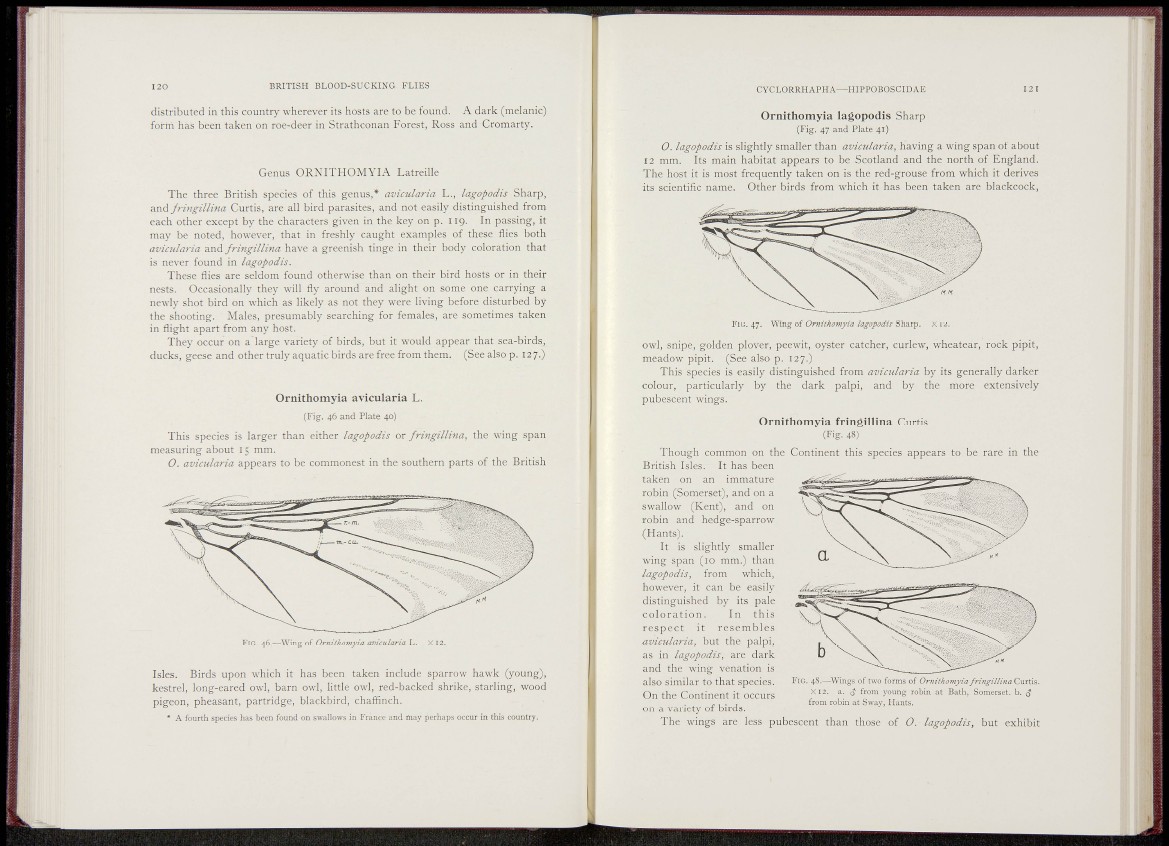
I 20 BRITISH BLOOD-SUCKING FLIES
distributed in this country wherever its hosts are to be found. A dark (melanic)
form has been taken on roe-deer in Strathconan Forest, Ross and Cromarty.
Genus ORNITHOlMYIA Latreille
The three British species of this genus,* avicularia L., lagopodis Sharp,
and fringillina Curtis, are all bird parasites, and not easily distinguished from
each other except by the characters given in the key on p. 119. In passing, it
may be noted, however, that in freshly caught examples of these flies both
avicularia and fri?igillina have a greenish tinge in their body coloration that
is never found in lagopodis.
These flies are seldom found otherwise than on their bird hosts or in their
nests. Occasionally they will fly around and alight on some one carrying a
newly shot bird on which as likely as not they were living before disturbed by
the shooting. Males, presumably searching for females, are sometimes taken
in flight apart from any host.
They occur on a large variety of birds, but it would appear that sea-birds,
ducks, geese and other truly aquatic birds are free from them. (See also p. 127.)
Ornithomyia avicularia L.
{Fig, 46 and Plate 40)
This species is larger than either lagopodis or fringillina, the wing span
measuring about 15 mm.
O. avicularia appears to be commonest in the southern parts of the British
FIG. 46.—Wing of OrJiithomyia avicularia L. X 12.
Isles. Birds upon which it has been taken include sparrow hawk (young),
kestrel, long-eared owl, barn owl, little owl, red-backed shrike, starling, wood
pigeon, pheasant, partridge, blackbird, chaffinch.
* A fourth species has been found on swallows in France and inay perhaps occur in this country.
CYCLORRHAPHA—HIPPOBOSCIDAE 1 2 1
Ornithomyia lagopodis Sharp
(Fig. 47 and Plate 41)
O. lagopodis is slightly smaller than avicularia, having a wing span of about
12 mm. Its main habitat appears to be Scotland and the north of England.
The host it is most frequently taken on is the red-grouse from which it derives
its scientific name. Other birds from which it has been taken are blackcock,
FIG. 47. Wing of Ornithotnyia lagopodis Sharp. X 12.
owl, snipe, golden plover, peewit, oyster catcher, curlew, wheatear, rock pipit,
meadow pipit. (See also p. 127.)
This species is easily distinguished from avicularia by its generally darker
colour, particularly by the dark palpi, and by the more extensively
pubescent wings.
Ornithomyia fringillina Curtis
(Fig. 48)
Though common on the Continent this species appears to be rare in the
British Isles. It has been
taken on an immature
robin (Somerset), and on a
swallow (Kent), and on
robin and hedge-sparrow
(Hants).
It is slightly smaller
wing span (10 mm.) than
lagopodis, from which,
however, it can be easily
distinguished by its pale
c o l o r a t i o n . In this
r e s p e c t it resembles
avicularia, but the palpi,
as in lagopodis, are dark
and the wing venation is
also similar to that species.
On the Continent it occurs
on a variety of birds.
FIG. 48.—Wings of two forms of Ornithomyia fringillina Curtis.
X12. a. cJ from young robin at Bath, Somerset, b. $
from robin at Sway, Hants.
The wings are less pubescent than those of O. lagopodis, but exhibit